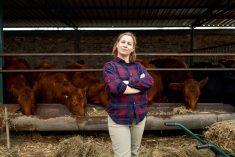I don’t know how better to describe the recommendations of the Canada Beef Working Group (CBWG). Rather than work to improve the Beef Information Centre (BIC) and Canada Beef Export Federation (CBEF), this group has decided to scrap both our domestic and international marketing organizations and start from scratch. It should not be a surprise. The merger of BIC and CBEF has been on the Canadian Cattlemen’s Association agenda for years. Their justification — it is more efficient to have one organization marketing our beef.
Read Also

A strategic approach to risk on the ranch
Given the increase in the value of livestock and the market volatility, we need to cover our risks. First,…
The CBWG plan is to create a new organization, give it a new name, Canada Beef, and hope to hell it works. Government wouldn’t screw it up this bad.
Why come down so hard on this issue? The reasons are many but before I get into it I want to acknowledge that I was once a very staunch critic of CBEF. Then I learned that beef exports and beef values are increased not because of CBEF but because CBEF members are going out and getting the job done with its support. I was confused about the federation’s role and I think that many producers still see CBEF as a company that should be out selling the beef.
The goal of the new Canada Beef is to raise the value of Canadian beef in international and domestic markets by positioning it as a premium product. This is a great goal, but it’s not up to organizations like BIC and CBEF to do it. It is up to the people who produce the product and own the boxes to sell the beef. BIC and CBEF support their marketing efforts. The CBWG thinks a new organization is needed to get the job done. The reality is the mechanism is already in place. It works. It’s the effort by those producing the boxes that is missing.
Selling boxed beef for higher values takes more than just bragging up the marbling score, the fact it is barley fed, age verified and cleared by the world’s most stringent inspection service. A brand needs consistency of product, and it takes time and effort to create an image of what the brand stands for. The question I have for the CBWG is how is this effort to brand and sell a differentiated product more obtainable under a new organization? I contend it will actually disrupt international sales and relations with customers as people leave or are replaced.
I can understand where the provincial funders are coming from. They want to see their checkoff dollars used effi-ciently. However, what they have been given is spin. All the studies that have looked at this issue in depth have said a merger will not achieve the desired outcomes. As producers we often think we can set lofty goals for exports and values on our product but we don’t want to have our fingers in it past owning a yearling or maybe the finished animal. Once we sell the animal, we sell our ownership and our ability to influence what we will get for that product.
As for the packers, the bigger they become, the more commodity oriented they have to be. Smaller players need to be part of that mix. It is these smaller operations that have to market on value and differentiation because they simply cannot compete on economies of scale. Under CBEF these small companies have as much say as the big boys and often do more marketing for Canadian beef than the big boys in the international arena.
I have immense respect for the producers who represent provincial associations on the BIC and CBEF boards. But until you have to sell the beef it is very difficult to grasp what it is like to deal with the multiple levels of bureaucracy and the ups and downs involved in the meat trade. This is where a federation composed of exporters, processors and producers is better equipped to respond to international opportunities as they arise. One where decisions and direction are not set by the employees but by those that have their businesses on the line and their fingers on the pulse of the meat trade every day.
Over the past decade, governments, both provincial and federal, have spent millions to encourage primary processing, value added and diversified beef exports beyond the U.S. market. They did this because they realize that for the beef business to change in this country it is the smaller brands and companies that will lead the way, not the entrenched giants. As a member of a small beef company I can attest to the fact that CBEF has helped us grow our exports because the federation treats small guys the same as big guys.
Under Canada Beef I fear this will change. Its board will be composed of one producer from each beef-producing province (one for the Maritimes), a cattle feeder, two big packers, a veal processor and a major exporter. It is not an elected board but appointed people who either know very little about boxed beef sales and the day-today marketing of beef or those who already have too much control of that end of the business. In other words the foxes will be guarding the hen house.
The last survey of CBEF members showed that 76 per cent are against a merger, primarily because they believe the organization is functioning well for what it is designed to do which is setting up a platform and opportunities for its members to market beef internationally. On the flip side CCA, the provincial cattlemen’s associations and CBWG have all but concluded that the merger is a done deal and must happen. My interpretation is that they have voted for continued consolidation rather than for choice. Ironic considering all the effort and money governments have given to help diversify the marketing of Canadian beef.
Dr.ChristophE.WederisapurebredAngusbreederinthePeaceregionofAlbertaandalsorunsSVRRanchConsulting.HeisalsoafoundingmemberofPrairieHeritageBeefProducers.Foradditionalinfocheckout www.spiritviewranch.com.















